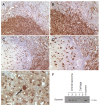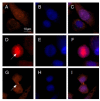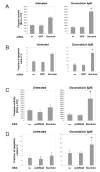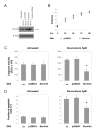The antiapoptotic gene survivin is highly expressed in human chondrosarcoma and promotes drug resistance in chondrosarcoma cells in vitro
- PMID: 21457573
- PMCID: PMC3076263
- DOI: 10.1186/1471-2407-11-120
The antiapoptotic gene survivin is highly expressed in human chondrosarcoma and promotes drug resistance in chondrosarcoma cells in vitro
Abstract
Background: Chondrosarcoma is virtually resistant to chemotherapy and radiation therapy. Survivin, the smallest member of the inhibitor of apoptosis protein family, is a critical factor for tumor progression and resistance to conventional therapeutic approaches in a wide range of malignancies. However, the role of survivin in chondrosarcoma has not been well studied. We examined the importance of survivin gene expression in chondrosarcoma and analysed its influences on proliferation, apoptosis and resistance to chemotherapy in vitro.
Methods: Resected chondrosarcoma specimens from which paraffin-embedded tissues could be extracted were available from 12 patients. In vitro experiments were performed in human chondrosarcoma cell lines SW1353 and Hs819.T. Immunohistochemistry, immunoblot, quantitative PCR, RNA interference, gene-overexpression and analyses of cell proliferation and apoptosis were performed.
Results: Expression of survivin protein was detected in all chondrosarcoma specimens analyzed, while undetectable in adult human cartilage. RNA interference targeting survivin resulted in a G2/M-arrest of the cell cycle and led to increased rates of apoptosis in chondrosarcoma cells in vitro. Overexpression of survivin resulted in pronounced resistance to doxorubicin treatment.
Conclusions: These findings indicate that survivin plays a role in the pathogenesis and pronounced chemoresistance of high grade chondrosarcoma. Survivin antagonizing therapeutic strategies may lead to new treatment options in unresectable and metastasized chondrosarcoma.
Figures







Similar articles
-
SDF-1/CXCR4 signaling up-regulates survivin to regulate human sacral chondrosarcoma cell cycle and epithelial-mesenchymal transition via ERK and PI3K/AKT pathway.Med Oncol. 2015 Jan;32(1):377. doi: 10.1007/s12032-014-0377-x. Epub 2014 Nov 27. Med Oncol. 2015. PMID: 25428386
-
The oncogene LRF is a survival factor in chondrosarcoma and contributes to tumor malignancy and drug resistance.Carcinogenesis. 2012 Nov;33(11):2076-83. doi: 10.1093/carcin/bgs254. Epub 2012 Jul 30. Carcinogenesis. 2012. PMID: 22847180
-
BAG3 promotes chondrosarcoma progression by upregulating the expression of β-catenin.Mol Med Rep. 2018 Apr;17(4):5754-5763. doi: 10.3892/mmr.2018.8611. Epub 2018 Feb 15. Mol Med Rep. 2018. PMID: 29484408 Free PMC article.
-
Investigations of survivin: the past, present and future.Front Biosci (Landmark Ed). 2011 Jan 1;16(3):952-61. doi: 10.2741/3728. Front Biosci (Landmark Ed). 2011. PMID: 21196211 Review.
-
Transcriptional regulation of the survivin gene.Mol Biol Rep. 2014 Jan;41(1):233-40. doi: 10.1007/s11033-013-2856-0. Epub 2013 Nov 7. Mol Biol Rep. 2014. PMID: 24197699 Review.
Cited by
-
Surgical outcome of malignant primary bone tumours in elderly and very elderly patients.Int Orthop. 2014 Oct;38(10):2149-54. doi: 10.1007/s00264-014-2400-4. Epub 2014 Jun 20. Int Orthop. 2014. PMID: 24947328
-
Targeting survivin as a potential new treatment for chondrosarcoma of bone.Oncogenesis. 2016 May 9;5(5):e222. doi: 10.1038/oncsis.2016.33. Oncogenesis. 2016. PMID: 27159675 Free PMC article.
-
Immunohistochemical investigation of cell cycle and apoptosis regulators (survivin, β-catenin, p53, caspase 3) in canine appendicular osteosarcoma.BMC Vet Res. 2012 Jun 11;8:78. doi: 10.1186/1746-6148-8-78. BMC Vet Res. 2012. PMID: 22686277 Free PMC article.
-
Src kinases in chondrosarcoma chemoresistance and migration: dasatinib sensitises to doxorubicin in TP53 mutant cells.Br J Cancer. 2013 Sep 3;109(5):1214-22. doi: 10.1038/bjc.2013.451. Epub 2013 Aug 6. Br J Cancer. 2013. PMID: 23922104 Free PMC article.
-
Survivin is a prognostic indicator in glioblastoma and may be a target of microRNA-218.Oncol Lett. 2019 Jul;18(1):359-367. doi: 10.3892/ol.2019.10335. Epub 2019 May 7. Oncol Lett. 2019. PMID: 31289507 Free PMC article.
References
-
- World Health Organization. Pathology and Genetics. Tumours of Soft Tissue and Bone. In: Fletcher CD, Unni KK, Mertens F, editor. World Health Organization Classification of Tumours. Cartilage tumours. Lyon, IARC Press; 2002. pp. 234–257.
-
- Eriksson AI, Schiller A, Mankin HJ. The management of chondrosarcoma of bone. Clin Orthop. 1980;153:44–66. - PubMed
-
- Dorfmann HD, Czerniak B. Bone Tumors. Mosby, St. Louis; 1998.
Publication types
MeSH terms
Substances
LinkOut - more resources
Full Text Sources
Medical

